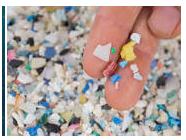Microplastics in molluscs
- Posted By
10Pointer
- Categories
Science & Technology
- Published
31st Dec, 2020
-
Context
- Researchers have found that mussels, oysters and scallops have the highest levels of microplastic contamination among seafood.
What are microplastics?
- Microplasticsare very small pieces of plastic that pollute the environment.
- Microplastics are not a specific kind of plastic, but rather any type of plastic fragment that is less than 5 mm in length.

What is the Classification of microplastics?
Two classifications of microplastics currently exist.
- Primary microplastics: They are any plastic fragments or particles that are already 5.0 mm in size or less before entering the environment. These include microfibers from clothing, microbeads, and plastic pellets.
- Secondary microplastics: They are microplastics that are created from the degradation of larger plastic products once they enter the environment through natural weathering processes. Such sources of secondary microplastics include water and soda bottles, fishing nets, and plastic bags.
What are the sources of microplastics?
- Sewage treatment plants
- Car and truck tires
- Cosmetics industry
- Clothing
- Manufacturing
- Fishing industry
- Packaging and shipping
- Plastic bottles
- Face masks
What are the Environmental impacts of microplastics?
- Biological integration into organisms: Microplastics can become embedded in animals' tissue through ingestion or respiration. Various annelid species, such as deposit-feeding lugworms and Molluschave been shown to have microplastics embedded in their gastrointestinal tracts.
- Persistent organic pollutants:Plastic particles may highly concentrate and transport synthetic organic compounds (e.g. persistent organic pollutants, POPs), commonly present in the environment and ambient seawater, on their surface through adsorption. Microplastics can act as carriers for the transfer of POPs from the environment to organisms.
- Buoyant biofilm layer: Microplastics can also form a buoyant biofilm layer on the ocean's surface. Buoyancy changes in relation to ingestion of microplastics have been clearly observed in autotrophsbecause the absorption can interfere with photosynthesis and subsequent gas levels.
What are the proposed solutions?
- Researchers have proposed incinerating plastics to use as energy, which is known as energy recovery.
- Recycling plastics is considered a more efficient solution.
- Increasing education through recycling campaigns is another proposed solution for microplastic contamination.
- Biodegradation is another possible solution to large amounts of microplastic waste. In this process, microorganisms consume and decompose synthetic polymers by means of enzymes.
